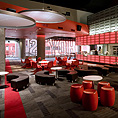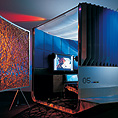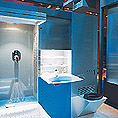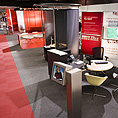











HyperloungeA project by Crowd Productions and David Poulton architectsHyperlounge [hyper as in hyper-text, information designed to connect you] has been a two year research project by Crowd Productions and David Poulton architects to develop ideas for that great Australian institution; the lounge room. The project's outcome is a series of nomadic media-on-demand viewing capsules for the Australian Centre for the Moving Image at Federation Square. These capsules are the first fully functioning built spaces to come from Hyperhouse, a project begun in 1990 by Crowd Productions, Cash Engineering Research and David Poulton to experiment with new ways of making space. |
In research conducted over the last decade with Anthony Kitchener from Cash Engineering Research we came to the conclusion that to exploit the possibilities for the design and construction of built space using new technology, time and money for research and development must be considered vital elements. Architecture and the traditional construction industries believe they operate on a scratch-built or craft model. Architects, clients and builders pretend that each new building starts with a clean sheet of paper. This is in order to make each project authentically unique and novel, just like a piece of art or craft. In fact all today's buildings are kits of parts, and often almost identical, as a visit to any building site will attest, save for the addition of some last minute trimmings. The windows, service systems, structural members and internal and external skins are all made from modules industrially mass produced offsite by general suppliers. The builders then spend 8 months to 2 years in the rain, on a mud-covered site putting it together. This does not seem logical to us. |
Our response has been three fold. Firstly we accept that buildings are already made of mass produced components. So we have thought about how to exploit this fact; to make things interchangeable, upgradable and reconfigurable. How we connect the systems becomes our art. Secondly the entire building is built in a controlled environment with ideal conditions and the best machinery; in a factory. Thirdly because the first two decisions give us the optimal way of constructing and integrating diverse elements we have used this opportunity to source and construct far more technologically adventurous elements. Using this strategy we have copied the car industry construction model. However, rather than give the problems associated with new construction techniques to others to solve we have made the understanding of this technology our concern. Like the composers of contemporary Techno dance music, who use the computer to allow them to build and mix their own music, often without leaving the bedroom, we wanted to control the cost of research and development by implementing a hands on approach, experimenting with and building the new systems ourselves. This diverges significantly from contemporary architectural practice. Few architects spend time wrestling with the assembly of building components on site. In fact I'm sure it's probably illegal and anyway the image it conjures up is terribly undignified. However it seems to us that unless one has had first hand experience with the elements one is building with, you will not really know their nature and this will reduce your ability to learn and innovate. It is strange that in other disciplines from art to surgery we do not trust those who are not practitioners as well as theoreticians or concepualisers. Our desire is to fold all of the experience in developing new forms or techniques into both our design thinking and detailing to optimize its impact on our ability to respond as designers. These responses are not incidental to our designing but central and the whole process is a dynamic one. |
 |
page: 1 | 2 | 3 | 4 | 5 |
2008 © Crowd

